Cover Story
WAITING FOR THE GREAT RIDE

It's a Sunday and 65-year-old retired locomotive master Kazi Yousuf has come back to his old place of work at Kamlapur Railway Station. A possible call back to his old post brought him and a few other colleagues to the station after several years. Reliving the past is only natural. The 65-year-old veteran remembers the most memorable day in his life--the first day he drove a train all by himself.
Shahnaz Parveen
Photos: Zahedul I Khan
“It took me around 10 years to get to the locomotive-master's seat. At that time for many in my village it was a dream job", says Yousuf who joined as an engine cleaner in 1969 and became a train driver after four phases of promotion.
"It was the 55-up train in Mymensingh to Dhaka route. All the coaches were packed with passengers. I felt a mixture of anxiety and thrill", he recalls sitting in a corner at one of the shabby offices in the station.
Yousuf admits the office buildings and stations were as shabby as they are now but back in those days the railway could boast being the principal mode of transport of the country. There was hardly any competition from any other transport sector. To get to any place, inside or outside the city, going by train was the obvious choice. The service on the train was of a high standard says Yousuf.

Many passengers illegally board trains, risking fatal injuries and depriving the exchequer of revenues
It was a different scene when trains arrived at the station those days. Yousuf is full of praises. Well-maintained and enjoying a grandeur few other vehicles could compete with, the railway was a symbol of modern life. Engines were new and able to haul coaches efficiently. Tracks were comparatively in good shape. Accidents were much less than today, the average speed being around 60km. Trains also kept to the schedule.
"This promising scenario however changed significantly over the years", Yousuf laments, "the railway seems to be dragging its feet. Everything is falling apart. People mostly prefer buses these days.”
Md Zakir Hossain, a poultry businessman can relate to the veteran rail worker well. "My father was a rail official for 36 years and joined the British Rail in 1945. During childhood my life revolved around trains, tracks and rail stations but today I prefer buses to go about."
The first thing Zakir notices while on a train is the shabby uniforms of the officials. To him this is a manifestation of the appalling condition of the railway: "I never noticed a crease on my father's uniform. Today the uniform and the basic condition of how the clients are served is a clear indication of the railway's decline."

Railway is still preferred by travellers, as it is considered cheap and safe.
"We used to wait for the food served on the train. I still remember the taste of the pudding served on the buffet car after dinner", he says.
Today the first thing one notices at a train station is the stench of human waste that dominate all other smells. While on board a different whiff greets the passengers added with the dusty, grimy interior. "The frayed seat padding infested with bedbugs, the discoloured coaches, the holes on the floors and on top of it, the bad time management, all of it is now overtaking my sweet memories", he remarks. Zakir mentions that although buses cost double the amount he is still opting for that mode of transport just to avoid the discomfort of the railway.
The glory days of railway that still stir up emotions in Yousuf and Zakir has undergone a sad transformation since independence with passengers gradually shifting towards road transport. Bangladesh Railway has seen its passengers reduced by 26 percent and freight volumes by 33 percent since independence although the country's population has doubled during the period.
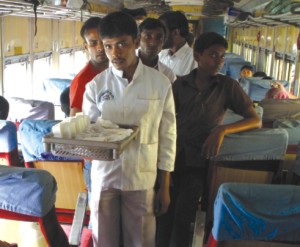 |
Food served on the train is not always hygienic. |
According to the Bangladesh Railway information book, in 1969-70 financial year the most popular mass transport of that time carried about 72 millions of passengers. In 2001-02 the number of train passengers shrunk to 38 million, the lowest in history. With a slight increase in recent times the number of train passengers now stands at about 65 million annually.
The story of the Bangladesh Railway dates back to November 15, 1862. Its journey started with only 53 kilometres of board gauge line in between Darsana and Jagati. The railway gradually became the primary mode of transport between the two Bengals and Assam for both passenger and goods transport.
After almost 150 years later, the oldest transport mode of the country is weighed down with massive corruption, acute financial crisis and numerous operational bottlenecks. It still operates with primitive technology. Its passengers nowadays can only reflect their dismay and irritation at the sorry state of the railway.
Instead of expanding the network, the rail track has actually been significantly reduced since the British left the continent. Most tracks of the railway are in a dilapidated condition, especially the branch lines, making it treacherous to travel in many routes. Only 44 districts are covered by railway.
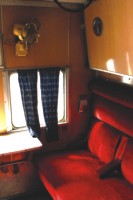 The use of an age-old manual and semi manual signalling system is increasing both human and mechanical failure. The signalling system installed as far back as 1927, is still being used. Engines and coaches have already exceeded their average economic life a long time ago and old engines and rundown coaches are offering passengers more discomfort than service. Plagued by personnel and engine shortage, train punctuality is down to 66 percent. The use of an age-old manual and semi manual signalling system is increasing both human and mechanical failure. The signalling system installed as far back as 1927, is still being used. Engines and coaches have already exceeded their average economic life a long time ago and old engines and rundown coaches are offering passengers more discomfort than service. Plagued by personnel and engine shortage, train punctuality is down to 66 percent.
The end result of all this is more than six billion taka annual loss.
Experts say years of negligence and misguided policies by all previous governments have turned the state-owned enterprise into a losing concern of gigantic scale. Veteran rail employee Dewan Md Ali, Chairman of Rail Workers Union tries to explain some key factors that led to this downfall and shift in passengers.
"The main blame goes to the wrong policies of expanding the road transport sector and lack of investment (in the railway) on time", says Ali.
The Government's policy of focusing mainly on the development of road transport sector shifted all the investment there completely ignoring the railway which remained without proper investment for many years. It also caused the railway to lose many of its passengers as well as misuse of resources explains Ali.
According to a study conducted by Bangladesh Rail Jote, when the British left in 1947 there were 2800 km of rail track in Bangladeshi territory whereas road network was only 600km. In 2009, rail track increased only 35km while road network increased to 50,000 thousands kilometres.
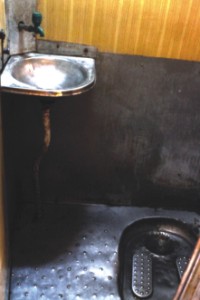 |
Shabby seats and unclean toilets make many weary of taking a train journey. |
“It shows the amount of investment made in two sectors and how the rail sector was ignored. India and Bangladesh inherited similar rail infrastructures from the British. When we ignored a transport system with great potentiality, India showed wonders”, he adds.
Ali blames donor agency prescription as one of the reasons that instigated the abandonment of such a promising sector. He pointes out that since 1982 donors have suggested massive layoffs, abolition of the railway board, a whole new organogram, shut down of many stations, branch lines and many other changes that did not help the agency. In fact the Bangladesh Railway did not have any profit record since 1982.
Ali puts part of the blame on politicians. "During elections MPs promises new roads but they never talk about railway. It is because a new road is more visible to the general people than changes in rail infrastructure", he remarks.
Besides, new roads mean more room for corruption for a certain segment. Giving a tender for road construction is less complicated than developing rail infrastructure, he mentions. Experts working on railway say it is high time the government changed its priority.
Abu Naser Khan, Convenor of Bangladesh Rail Jote, a platform of organisations working on the development of railway says the Bangladesh Railway can still be developed as a profitable, low-cost, environmentally friendly and safe mass transit. Steps should be taken on the highest priority basis, he stresses.
The advantages of railway are many, points out Khan. Trains can carry a huge volume of passengers and goods, which cuts down energy demand, pollution and average operational cost. The number of accidents is low and there is no traffic jam either”, he adds. Passenger carrying capacity of a 15 coach intercity train is equal to around 40 luxury buses while a freight train can carry goods equal to around 250 trucks (with 5 ton capacity), he informs.
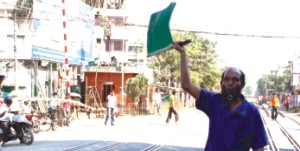 |
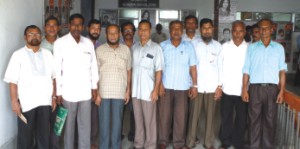 |
The Bangladesh Railway has to upgrade its signalling system by arming its staff with modern equipment. |
Retired train drivers called back for possible recruitment. |
According to a study conducted by Bangladesh Rail Jote, the transport cost of railway is the lowest among all other modes of transport. Per kilometre travel expense of railway was Tk.00.38 in 2007 whereas travel cost of passenger carrying bus was Tk.00.87.
Bangladesh's landscape makes it ideal for railway networks. All the important districts are situated within a 300km distance from the centre point Dhaka while the feature of land is mostly plain. For a land scarce country like Bangladesh the railway has another important advantage, which is expansion of the railway networks involve less land acquisition. On the other hand, road network involves acquiring of a huge amount of fertile agricultural land, a lot more than railway, Naser explains.
“Initial investment of railways seems more as it requires building of tracks, stations, signalling system, procuring locomotives and coaches” says Naser. “However in the long run it is cost effective than any other transport mode.”
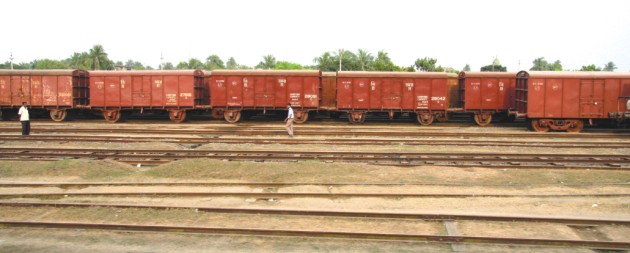
Overhauling of the age-old rail service is the order of the day.
Naser also points out improving railway will cutback the import of motor vehicles and fuel from abroad saving a large amount of foreign currency. However, improving the railway alone will not help. Naser suggests creating a well-synchronised multimode transportation system by improving network between railway, road, waterways, connecting industrial zones and different ports. Departure timings of train, bus and launch ferries also have to synchronised.
The Convenor of Bangladesh Rail Jote also stresses on changing train timings as per people's demand especially targeting the commuters from districts surrounding Dhaka such as Joydevpur, Narayanganj, Comilla, Tangail, Bhairob, Narshingdi, Brahmanbaria with special trains for officer goers.
 He recommends transferring rail division from the communication ministry and creating a separate ministry for railway like India. Naser is against privatisation of railway; instead recommends public-private partnership. He recommends transferring rail division from the communication ministry and creating a separate ministry for railway like India. Naser is against privatisation of railway; instead recommends public-private partnership.
However he points out that railway can only be salvaged if there is enough political will. "The refreshing news is that the current government is showing interest in railway and increasing funding but steps taken so far is not enough compared to the level of attention it deserves", he says.
While experts mull different possible options, the top man at railway, Director General TA Chowdhury explains what the railway desperately needs right now is massive investment on primary infrastructures. "Performance of railway is going down as we are in desperate need of all the basic assets such as locomotives, coaches, modern signalling system, track renovation, double track in certain routes and manpower recruitment", he says. “There is a need to built new tracks and bring more people under BR coverage by connecting more districts.”
According to information from BR, railway operates 265 trips daily across the country but only 223 engines are in running condition. Sometimes it goes further down. About 50 percent of these engines are 40 years old and are gradually becoming inefficient while there is a shortage of coaches. About 40 percent of the railway's signalling system is still manual and 43 percent semi-manual, which increases risk of accidents.
The official adds that the Bangladesh Railway now has 698 posts of locomotive masters and 435 stationmasters vacant, which is more than half of its requirement. In total, our national railway now has a shortage of 14,157 staff. "The list is too long and requires massive investment. In fact the entire system needs overhauling", the DG points out.
 |
Relic of the past. The gateman still uses this ancient telephone set for communication. |
The official however assures that Awami League government is giving highest priority to the development of railway to create a pro-people transport system. “The government has undertaken a 20 year old master plan for the development of the railway sector. An additional amount has been allocated in the budget for railway this fiscal year, which is comparatively higher than the last seven years”, he says.
The master plan includes plans to integrate Bangladesh Railway with the Trans Asian Railway Network. There will also be projects to construct double line in Dhaka-Chittagong route, procurement of locomotives, coaches, remodelling of stations and modernising signalling system. The DG also says that the donor agencies are supporting the Bangladesh Government to improve the efficiency and capacity of the railway.

Slums have mushroomed dangerously close to the tracks. As the rail authority turns a blind eye, many travel on the roof of the train, posing a great risk for the travellers.
What everyone expects from the authorities is not to surrender viable projects for the sake of political convenience, which was the case on previous occasion, states Abu Naser from Rail Jote, a sentiment shared by Ali from the workers union. Meanwhile regulars, potential train goers and present and retired officials like Kazi Yousuf can only hope that the railway is revamped and revitalised into a modern, efficient and safe means of transport.

Acute apathy. People stand on the tracks defying the risk of injury and death.

Kamlapur Railway Station is always swarmed by touts, who, in connivance with unscrupulous railway officials, sell tickets at an exorbitant price.
Copyright
(R) thedailystar.net 2010 |
